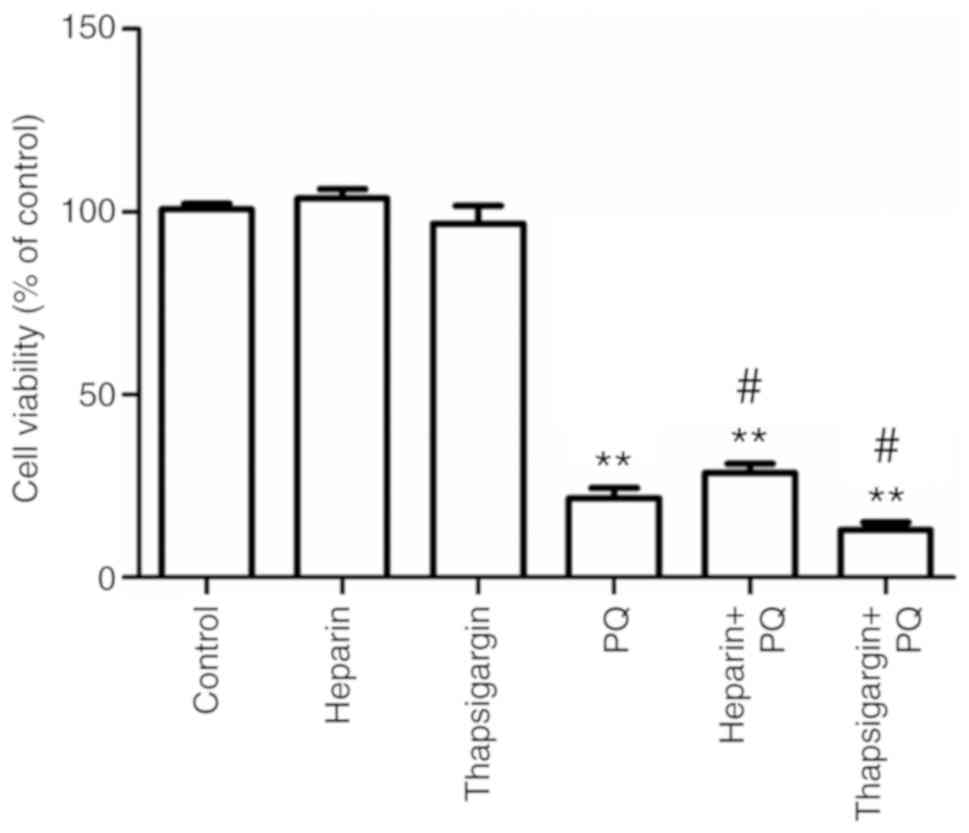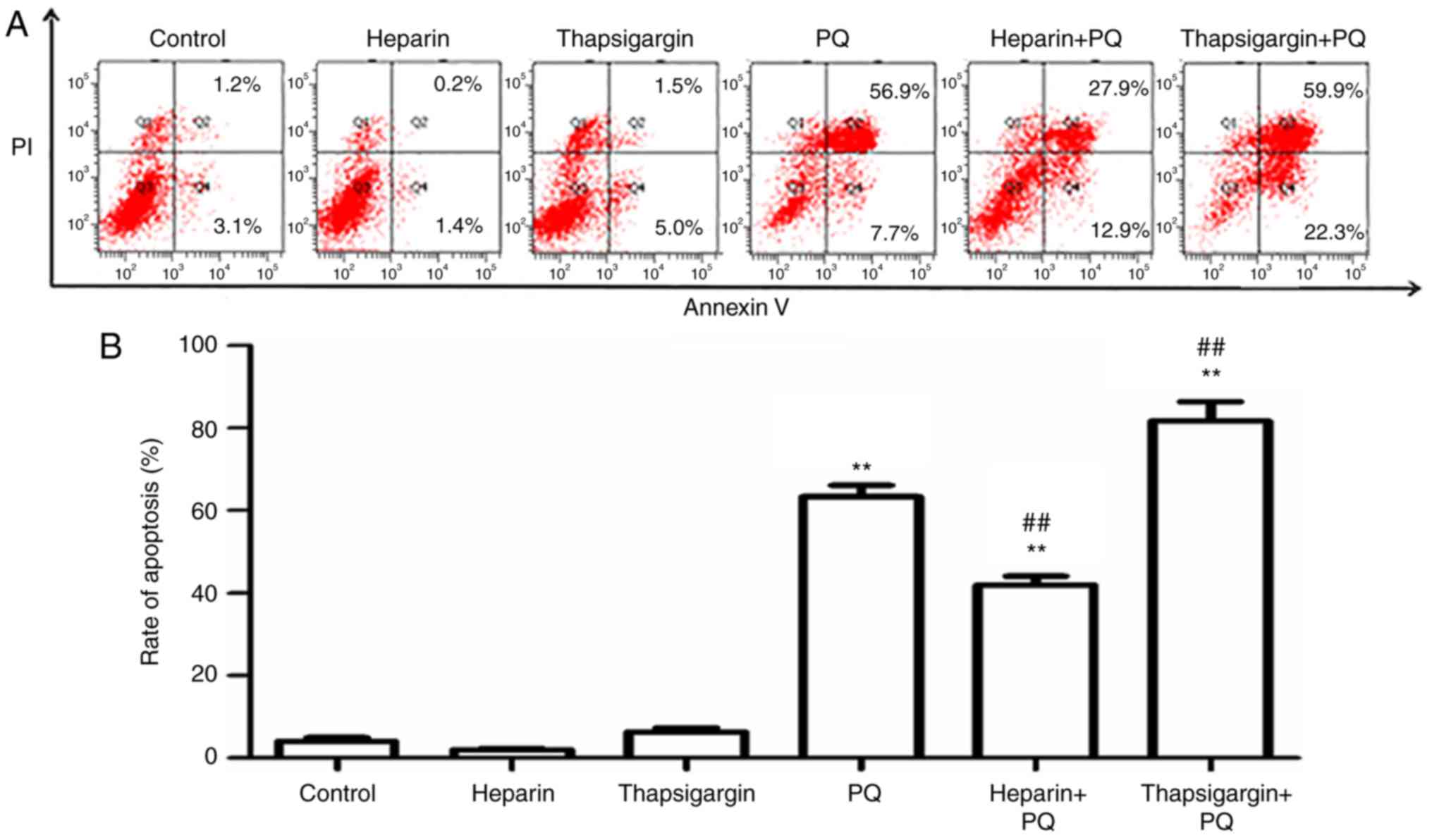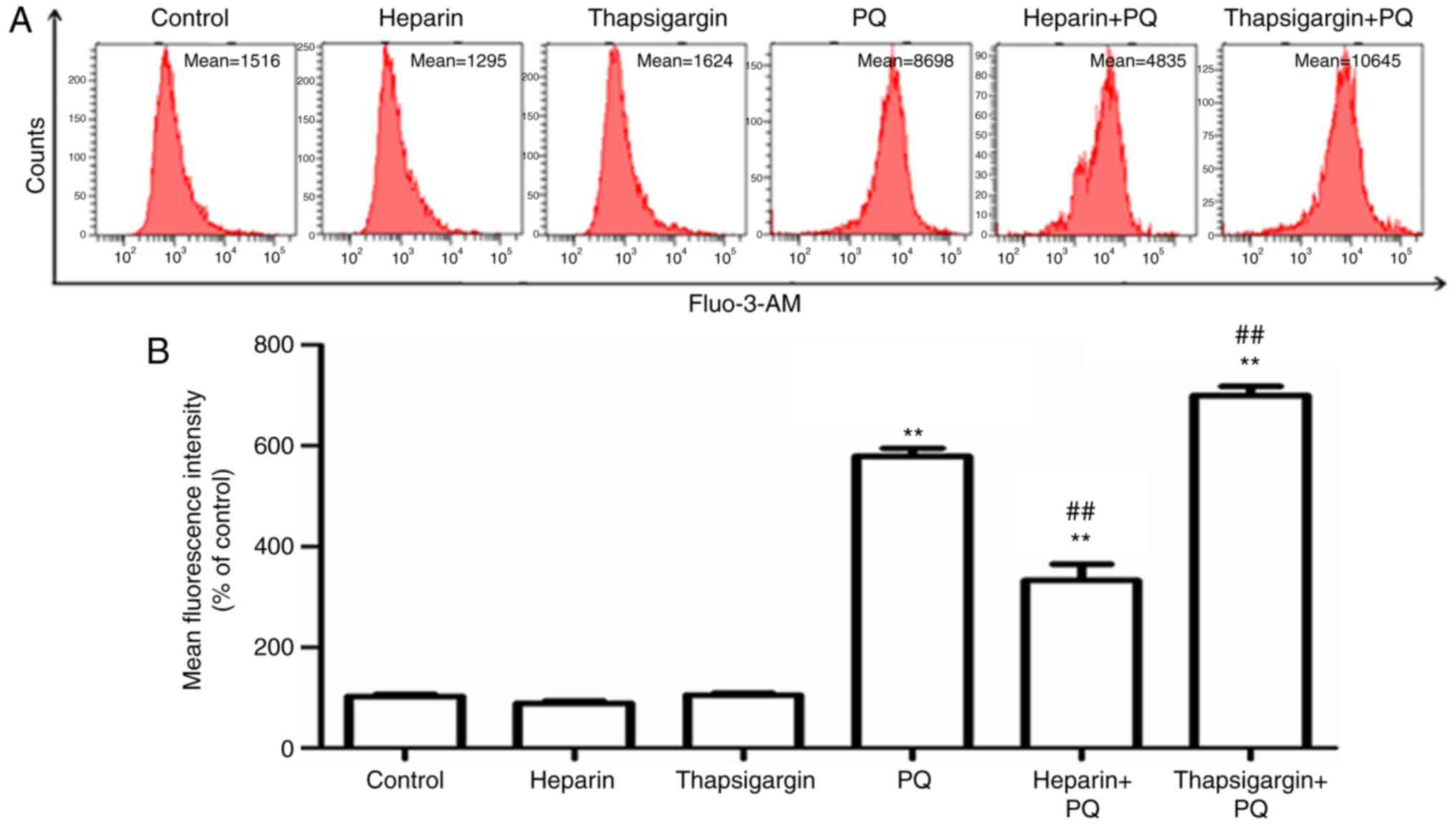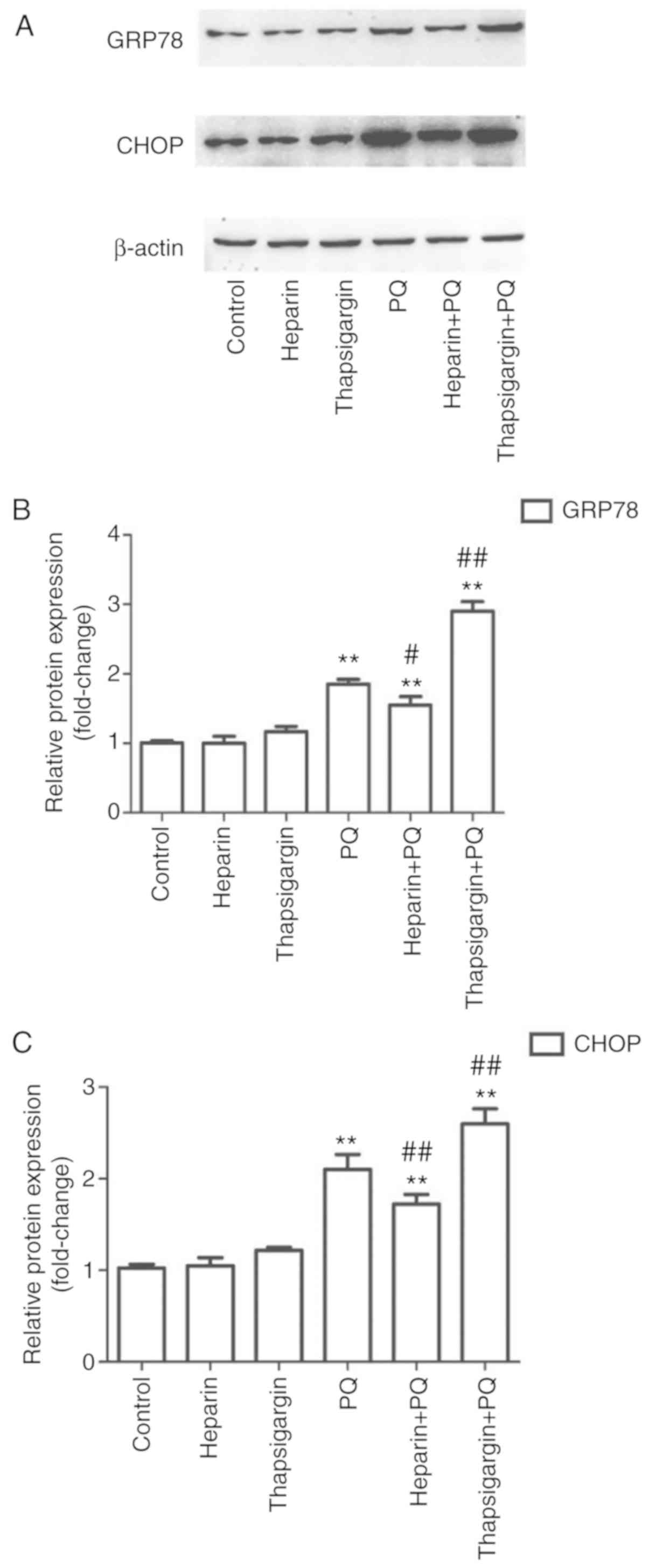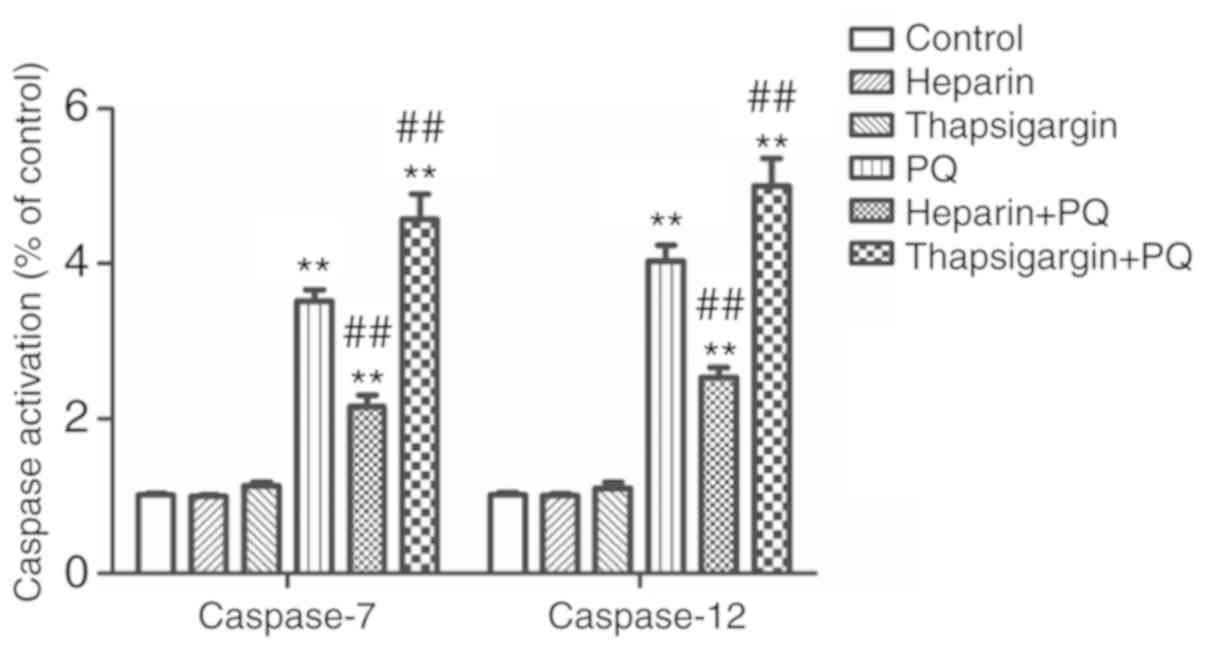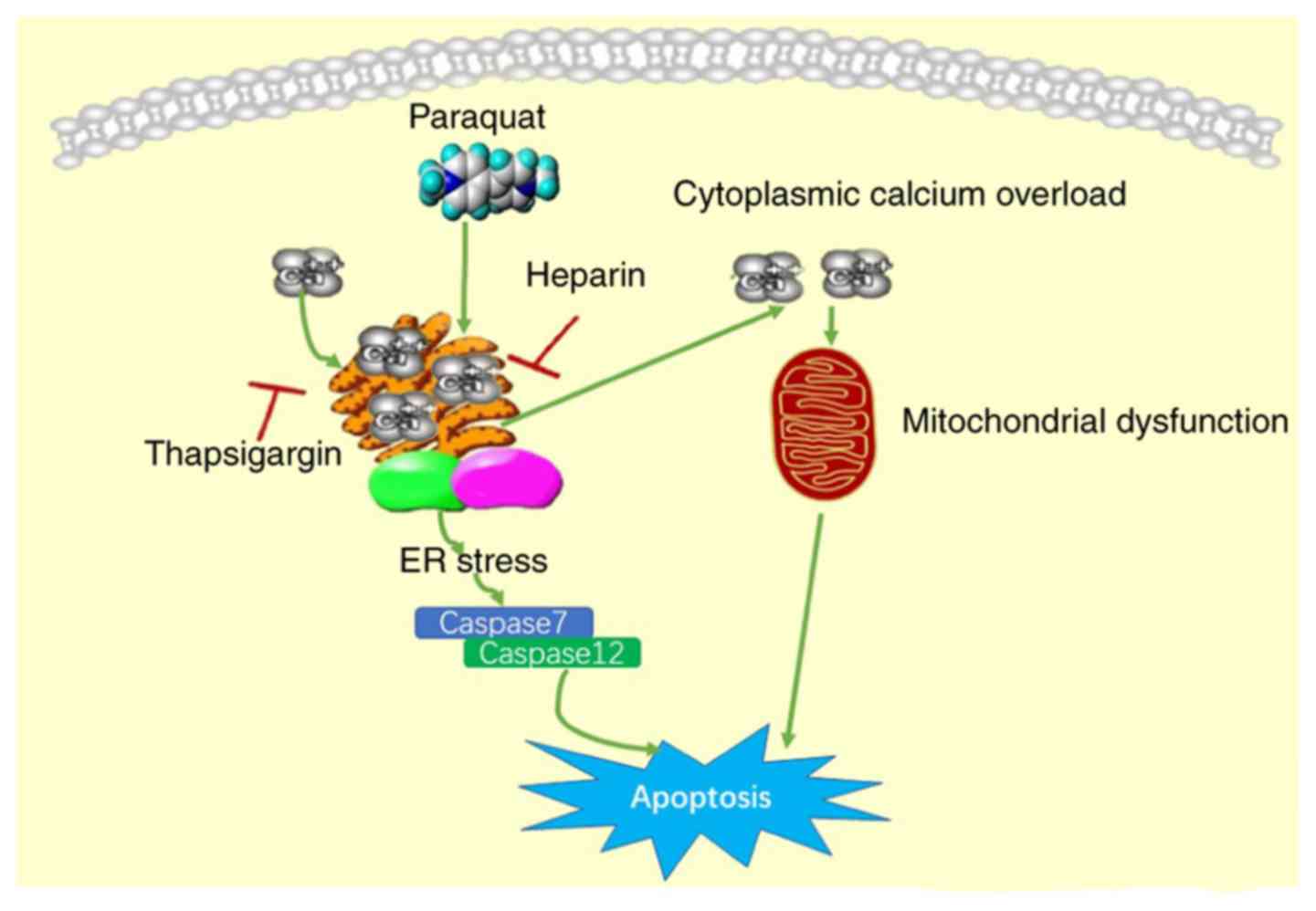Effect of endoplasmic reticulum calcium on paraquat‑induced apoptosis of human lung type II alveolar epithelial A549 cells
- Authors:
- Published online on: July 4, 2019 https://doi.org/10.3892/mmr.2019.10469
- Pages: 2419-2425
Abstract
Introduction
Paraquat (PQ), also known as 1,1′-dimethyl-4,4′-bipyridinium dichloride, is a highly effective quaternary ammonium herbicide that has been widely used in agriculture worldwide (1). Its misuse by humans can result in multiple organ dysfunction and lung injury, and this compound has an extremely high fatality rate with no specific antidote available (2). To date, the mechanism involved in the toxic effect of PQ remains unknown. Certain studies have indicated that the apoptosis of alveolar epithelial cells is a key in the early manifestation of pulmonary fibrosis caused by PQ (3,4). Previous studies have also revealed that PQ induced the apoptosis of human lung type II alveolar epithelial A549 cells mediated by the endoplasmic reticulum stress (ERS) pathway (5).
Calcium (Ca2+), an important signal transduction molecule in the endoplasmic reticulum (ER), drives the cell apoptosis by ERS and mitochondrial apoptosis pathway (6). The highest concentration of Ca2+ in cells is found in the ER, and thus the ER serves an important role in maintaining the Ca2+ stability. Ca2+ homeostasis in cells is achieved through the Ca2+-ATP enzyme pump in the ER, which absorbs Ca2+ from the cytoplasm, and inositol 1,4,5-triphosphate receptor (IP3R), which regulates the release of Ca2+ from the ER (7). When the Ca2+ homeostasis in the ER is damaged, physiopathological changes in cells occur, such as ERS, changes in mitochondrial membrane permeability, the release of cytochrome c, and dysregulation of B-cell lymphoma 2 (Bcl-2) and Bcl-2-associated X protein, which results in cell apoptosis (8,9). However, it is unclear whether ER Ca2+ plays an important role during the apoptosis of human lung type II alveolar epithelial A549 cells induced by PQ.
Therefore, in the present study, the Ca2+-ATP enzyme inhibitor thapsigargin and the IP3R inhibitor heparin were used to preprocess A549 cells, followed by exposure to PQ to induce cell apoptosis. The cell activity, nuclear form, Ca2+ concentration, apoptosis rate, expression levels of the ERS marker proteins glucose-regulated protein 78 (GRP78) and C/EBP homologous protein (CHOP), and changes in caspase-7/12 activity were detected to determine whether ER Ca2+ was involved in the PQ-induced apoptosis of human lung type II alveolar epithelial A549 cells. This was explored to provide a theoretical basis for the clinical treatment of PQ poisoning.
Materials and methods
Cells and reagents
The A549 cell line was obtained from The Chinese Academy of Sciences Cell Bank. RPMI-1640 medium was purchased from GE Healthcare Life Sciences (Hyclone; Logan, UT, USA) and fetal bovine serum (FBS) was from Gemini Bio-Products, Inc. PQ and trypsin were purchased from Merck KGaA (Sigma-Aldrich), heparin and thapsigargin were obtained from Beijing Solarbio Science and Technology Co., Ltd. (Beijing, China), while Hoechst 33258 stain was from Beyotime Institute of Biotechnology (Shanghai, China). The Annexin V-FITC/PI kit was purchased from Dojindo Molecular Technologies, Inc. (Kumamoto, Japan), Calcium detection kit and the Caspase activity kit was from Nanjing Keygen Biotech Co., Ltd. (Nanjing, China). Antibodies against GRP78 (cat. no. 66574-1-Ig), CHOP (cat. no. 15204-1-AP) and β-actin (cat. no. HRP-60008) were purchased from ProteinTech Group, Inc. Horseradish peroxidase-conjugated goat anti-rabbit (cat. no. ab6721) goat anti-mouse immunoglobulin G secondary antibodies (cat. no. ab97040) and ECL Substrate kit (cat. no. ab133406) were purchased from Abcam.
Cell culture and grouping
A549 cells were cultured in RPMI-1640 culture solution with 10% FBS in an incubator with 5% CO2 at 37°C. The culture solution was changed every other day. At 70–80% confluence, cells were divided into six experimental groups, as follows: i) Control group, exposed to equal volume of PBS; ii) heparin group, preprocessed with heparin (200 µg/ml) for 2 h; iii) thapsigargin group, preprocessed with thapsigargin (4 µM) for 2 h; iv) PQ group, exposed to PQ (200 M); v) heparin + PQ group, preprocessed with heparin (200 µg/ml) for 2 h, followed by PQ (200 µM) treatment; vi) thapsigargin + PQ group, preprocessed with thapsigargin (4 µM) for 2 h, followed by PQ (200 µM) treatment. Cells in each group were cultured for 48 h, and a number of relevant indexes were then tested.
Cell activity detection by MTT assay
A total of 1×105 cells/ml were seeded onto a 96-well plate, with each well containing 100 µl of solution, and cultured for 24 h. Next, the cells were treated accordingly in the different groups and continuously cultured for 48 h after treatment. A total of 20 µl MTT solution (5 mg/ml) was added into each well and mixed, and the cells were continuously cultured for 4 h in an incubator with 5% CO2 at 37°C. Subsequently, the supernatant was discarded, and 150 µl DMSO was added to each well. The cells were shaken in the dark for 10 min to dissolve the formazan crystals. A microplate reader at 490 nm was used to determine the optical density (OD) of each well.
Cell apoptosis detection by Hoechst 33258 staining
The culture solution was discarded after 48 h of incubation, and the cells were collected. Paraformaldehyde (4%) was added to fix for 10 min at room temperature. The fixation solution was then discarded, and the cells were washed three times with PBS. Next, Hoechst 33258 stain was added for 5 min and then discarded after washing three times with PBS. After mounting with an anti-fluorescence quenching agent the cell nuclei were observed under a microscope.
Cell apoptosis rate detection using the Annexin V-FITC/propidium iodide (PI) double-staining method
A549 cells were seeded onto a 6-well plate at a density of 1×106 cells/well. When cells reached 70% confluence, they were processed accordingly in the different groups, and continuously cultured for 48 h. After the 48 h culture, cells in each group were collected, washed three times with PBS, and then incubated with a mixture containing 5 µl Annexin V-FITC and 5 µl PI for 15 min at room temperature in the dark. A flow cytometer was subsequently used for the detection of apoptosis rate.
Measurement of Ca2+ concentration
Cells collected from each group were placed into culture solutions with 1.25 µM Fluo-3 AM probe of the Calcium Detection Kit (Nanjing Keygen Biotech Co., Ltd.) and incubated for 30 min at 37°C in the dark. Subsequent to incubation, the cells were washed three times with PBS and resuspended in 300 µl PBS in a flow tube. A flow cytometer was then used for the detection of Ca2+ concentration.
Detection of the protein expression levels of GRP78 and CHOP by western blot analysis
Cells collected from each group were washed three times with PBS and lysed with a lysis buffer consisting of dichloroacetic acid (0.1%), PMSF (1 mM), protease inhibitor cocktail (10 µM), Na3PO4 (1 mM), Triton X-100 (1%), NaCl (150 mM), Tris-HCl (10 mM), EDTA (1 mM) and EGTA (1 mM). Next, centrifugation was performed for 30 min at 14,000 × g at 4°C, and the supernatant was collected and transferred into a new EP tube. The BCA method was then used to measure the protein concentration. Subsequently, 30 µg of the sample was loaded and separated by 12% SDS-PAGE at 4°C at 70 V for 60 min. The protein was then transferred to a PVDF membrane and incubated for 2 h at room temperature with blocking solution that consisted of 5% nonfat milk powder dissolved in Tris-buffered saline/Tween-20 (TBST). Antibodies targeting GRP78 (1:500), CHOP (1:1,000) and β-actin (1:1,000) were added, and the membrane was fixed overnight at 4°C and maintained at room temperature for 2 h. Subsequent to washing three times with TBST, secondary antibodies (1:5,000) were added to the PVDF membrane, maintained at room temperature for 2 h and washed three times with TBST. An ECL kit was used to visualize the protein bands. Finally, the image was developed and fixed, while ImageJ software (National Institutes of Health, Bethesda, MD, USA) was used to perform gray analysis.
Caspase activity detection
Cells collected from each group were washed three times with PBS. Lysis solution was added in moderation for 2 h on ice, and centrifugation was performed for 1 min at 11,000 × g at 4°C. The supernatant was collected and transferred into a new EP tube, and the BCA method was used to measure the protein concentration. Next, 50 µl of 2X buffer solution and 5 µl caspase substrate was added to 50 µl cell lysis product (containing 150 µg of protein), and incubated for 4 h at room temperature in the dark. The OD at 405 nm was measured using a microplate reader.
Statistical analysis
SPSS software (version 20.0; IBM Corporation, Armonk, NY, USA) was used to perform the statistical analysis. The data in each group are expressed as the mean ± standard deviation. Intergroup differences were assessed by one-way analysis of variance. If equal variance was assumed, Dunnett's test was used for comparisons between the two groups, whereas if unequal variance was assumed, Dunnett's T3 test was used. P<0.05 was considered to indicate a statistically significant difference.
Results
Changes in cell activity
Compared with the control group, there were no evident changes in the heparin and thapsigargin groups, which indicated that the concentrations of heparin and thapsigargin used in the present study exerted no cytotoxicity (Fig. 1). However, the cell activity in the PQ group was significantly decreased, which indicated that the concentration of PQ used in the present study had a strong toxic effect on A549 cells. Compared with the PQ group, the cell activity was significantly increased in the heparin + PQ group, while cell activity was significantly decreased in the thapsigargin + PQ group. These results suggested that the inhibitionof ER Ca2+ release was able to alleviate the cytotoxicity exerted by PQ, while the inhibition of ER Ca2+ absorption resulted in aggravation of cytotoxicity (Fig. 1). Taken together, these findings indicated that the cytotoxicity of PQ is correlated with the Ca2+ signal.
Changes in nuclear form
Compared with the control group, there were no evident changes in the nuclear form in the heparin and thapsigargin groups (Fig. 2). By contrast, characteristic changes, such as karyopyknosis, karyorrhexis and nuclear apoptosis, appeared at different degrees in the PQ, heparin + PQ and thapsigargin + PQ groups. Compared with the PQ group, fewer changes were observed in the nuclear form in the heparin + PQ group, while the nuclear form changes in the thapsigargin + PQ group were more prominent (Fig. 2). These findings indicated that Ca2+ signal had an effect on the A549 cell apoptosis induced by PQ.
Changes in cell apoptosis rate
Compared with the control group, there were no evident changes in the heparin and thapsigargin groups, which indicated that the concentrations of heparin and thapsigargin used in the experiments of the present study had no significant cytotoxic effect. However, in the PQ group, the cell apoptosis rate was significantly enhanced, which suggested that the concentration of PQ used in the present study was able to strongly induce A549 cell apoptosis (Fig. 3). In order to determine whether the Ca2+ signals of ER affect the rate of cell apoptosis induced by PQ, the apoptosis rate was measured in PQ-treated cells that were preprocessed with thapsigargin or heparin. As presented in Fig. 3, the cells apoptosis rates in the PQ, heparin + PQ and thapsigargin + PQ groups were increased by different levels compared with the control group. When compared with the PQ group, the cell apoptosis rate was significantly decreased in the heparin + PQ group, but was significantly increased in the thapsigargin + PQ group. These results further revealed that the Ca2+ signal of ER participated in the A549 cell apoptosis induced by PQ.
Changes in Ca2+ concentration in cells
Ca2+ is known to be an important signal transduction factor in eukaryotic cells, and maintaining its homeostasis serves an important role in the normal physiological activity of cells (10). Ca2+ overload in cells is usually an early manifestation of cell apoptosis and death. The Ca2+ influx from outside the cell, the activities of Ca2+ stores in the cells, and changes in Ca2+ spatial distribution may cause Ca2+ overload in cells (11). In order to investigate the influence of PQ on Ca2+ concentration in cells, a Fluo-3 AM fluorescent probe was used to detect the changes in Ca2+ concentration. The results revealed that, compared with the control group, the Ca2+ concentration in cells treated with PQ was significantly increased, indicating that PQ induced Ca2+ overload in cells (Fig. 4). Heparin, an inhibitor of IP3R in the ER, and thapsigargin, an inhibitor of sarco-ER Ca2+-ATPases in the ER, were used to determine the association between Ca2+ overload in the cells and Ca2+ in the ER. The results indicated that, compared with the PQ group, Ca2+ fluorescence intensity was significantly decreased in the heparin + PQ group, indicating that heparin prevented the release of Ca2+ in the ER and significantly reversed the increase in Ca2+ concentration induced by PQ. By contrast, a marked increase in Ca2+ fluorescence intensity was observed in the thapsigargin + PQ group as compared with the PQ group (Fig. 4). These aforementioned results suggested that Ca2+ overload in the cells existed during the A549 cell apoptosis induced by PQ, and that the ER served an important role in the imbalance of Ca2+ and outflow of Ca2+.
Changes in GRP78 and CHOP protein levels
In order to determine whether PQ induced ERS in A549 cells, the expression levels of two relevant proteins, GRP78 and CHOP, were determined. The results demonstrated that, compared with the control group, there were no evident changes in the heparin and thapsigargin groups, whereas the levels of the two proteins were significantly increased in the PQ group (Fig. 5). This suggested that PQ significantly induced ERS during the induction of A549 cell apoptosis. Compared with the PQ group, the expression levels of GRP78 and CHOP were significantly decreased in the heparin + PQ group and significantly increased in the thapsigargin + PQ group (Fig. 5). These results indicated that the intervention of Ca2+ release and absorption in the ER influenced the ERS.
Changes in caspase-7/12 activity
caspase-7 and caspase-12 are members of the Caspase protein family, and are defined as the executive proteins in cell apoptosis. The activation of caspase-7 and caspase-12 is necessary for the ERS-induced cell apoptosis. In the present study, the expression levels of caspase-7 and caspase-12 in each group was detected to determine whether PQ was able to promote Ca2+ release and reduce Ca2+ absorption, and influence and trigger A549 cell apoptosis mediated by ERS. As shown in the Fig. 6, the activities of caspase-7 and caspase-12 were increased by different degrees in the PQ, heparin + PQ and thapsigargin + PQ groups as compared with the control group. However, compared with the PQ group, the activities of caspase-7 and caspase-12 were significantly decreased in the heparin + PQ group, but significantly increased in the thapsigargin + PQ group (Fig. 6). These results revealed that intervention of Ca2+ signals in the ER has an effect on A549 cell apoptosis mediated by the ERS induced by PQ.
Discussion
The lung is the main target organ of PQ poisoning. Lung damage caused by PQ mainly manifests as pulmonary congestion, bleeding, edema, the formation of a hyaline membrane, degeneration, hyperplasia and fibrosis, resulting in acute lung injury and acute respiratory distress syndrome. Even when patients have survived through the acute phase, they may succumb due to respiratory failure caused by irreversible pulmonary fibrosis (12,13). Certain studies have suggested that the apoptosis of lung epithelial cells serves an important role in lung injury caused by PQ (3,4). Therefore, it would be of great importance to illustrate the mechanism of lung epithelial cell apoptosis induced by PQ.
Cell apoptosis is an ordered, programmed and active type of cell death, and is the normal physiological response of the cell nucleus stimulated by specific signals. However, abnormal cell apoptosis is associated with the occurrence of numerous diseases (14). The cell apoptosis regulation mechanism is complex, and the cell apoptosis pathway differs according to the different environments, types of cells or stimulations (15).
Ca2+ signals are responsible for various basic cell functions, and once the concentration of Ca2+ or its regulation function becomes abnormal, Ca2+ homeostasis is lost. Hence, a series of cascade reactions are activated, and cell apoptosis or death finally occurs (16,17). The ER is a membranous duct system distributed in the cytoplasm and is involved in material transportation in cells. Ca2+ concentration in cells is mediated by the ER, since Ca2+ is mainly stored in the ER. At present, studies have indicated that among all organelles, the ER is mainly in charge of the dynamic equilibrium of Ca2+ (18).
The present study suggested that PQ exposure was able to increase the Ca2+ concentration in cells and cause Ca2+ overload. When cells were preprocessed with thapsigargin to inhibit the ER from absorbing Ca2+, the Ca2+ concentration in the cytoplasm was further increased, indicating that the increase of Ca2+ concentration in the cytoplasm is correlated with the decrease in Ca2+ in the ER. By contrast, when cells were preprocessed with heparin to inhibit the release of Ca2+ in the ER, the Ca2+ concentration in the cytoplasm was decreased, indicating that the decrease in Ca2+ concentration in the cytoplasm is correlated with the decreased release of Ca2+ in the ER. These results suggested that PQ damaged the balance of ER Ca2+ release and absorption, and led to Ca2+ overload in the cytoplasm. Ca2+ overload in the cytoplasm can trigger the mitochondrial pathway apoptosis (19). In the current study, MTT assay, Annexin V-FITC/PI double staining and Hoechst 33258 staining were conducted to further reveal that thapsigargin evidently enhanced the cytotoxicity and apoptosis levels induced by PQ treatment. By contrast, heparin was observed to inhibit the release of Ca2+ in the ER and evidently reverse the cell apoptosis induced by PQ. These findings further indicated that PQ induced cell apoptosis by damaging the Ca2+ homeostasis in the ER.
GRP78 is the molecular chaperone of ERS, and serves a critical role in maintaining ER protein synthesis, properprotein folding and Ca2+ homeostasis in cells; thus, it is an important marker of ERS (20). CHOP, as the enhancer binding protein and homologous protein of CCAAT, is a pro-apoptotic protein that is highly expressed during ERS, while it exhibits low expression in the absence of ERS; therefore, it can serve as a marker protein of ERS (21). An increasing number of studies have suggested that cell apoptosis induced by ERS is implemented by the activation of caspase-7 and caspase-12 (22,23). In the present study, PQ was found to markedly increase the expression levels of GRP78 and CHOP, which are relevant markers of ERS, as well as enhance the activities of caspase-7 and caspase-12 (as summarized in Fig. 7). Preprocessing with thapsigargin significantly increased the expression levels of GRP78 and CHOP, and the activities of caspase-7 and caspase-12 in PQ-treated cells. By contrast, preprocessing with heparin markedly reversed the effects of PQ in cells. These findings indicated that the intervention of Ca2+ had an effect on A549 cell apoptosis mediated by PQ through the ER pathway.
All apoptotic pathways eventually activate caspase-3, and thus caspase-3 is a non-specific marker for certain apoptotic pathways. Other Caspases, such as caspase-8 and caspase-9, that are activated by special apoptotic pathways have been reported (24,25). Caspase-12, which is located in the adventitia of the ER, is a key molecule that mediates ERS-induced apoptosis and is only correlated with the mechanism of ERS-mediated apoptosis. There are several methods of caspase-12 activation induced by ERS, including Ca2+-dependent calpain activation and the caspase-7 pathway. Therefore, caspase-12 and the associated caspase-7 were investigated in the present study.
In conclusion, the results of the present study revealed that PQ had an effect on A549 cells by damaging the regulatory function of Ca2+ in the ER, which consequently resulted in Ca2+ overload and ERS, and triggered cell apoptosis. Furthermore, the study results suggested that, at the early stages of PQ poisoning, a considerable therapeutic strategy may be to prevent the ER Ca2+ release, maintain the Ca2+ homeostasis in the ER and cytoplasm, and prevent the apoptosis of lung epithelial cells.
Acknowledgements
Not applicable.
Funding
This research was supported by The Doctoral Scientific Research Foundation (Liaoning, China; grant no. 20141033).
Availability of data and materials
The datasets used and/or analyzed during the current study are available from the corresponding author on reasonable request.
Authors' contributions
XSD designed the study. QC analyzed the data. CY made substantial contributions to conception and design. CQS, DZS and YMX conducted the experiments. All authors reviewed, edited and approved the final version of the manuscript.
Ethics approval and consent to participate
Not applicable.
Patient consent for publication
Not applicable.
Competing interests
The authors declare that they have no competing interests.
References
|
Serra A, Domingos F and Prata MM: Paraquat intoxication. Acta Med Port. 16:25–32. 2013.(In Portuguese). | |
|
Ko DR, Chung SP, You JS, Cho S, Park Y, Chun B, Moon J, Kim H, Kim YH, Kim HJ, et al: Effects of paraquat ban on herbicide poisoning-related mortality. Yonsei Med J. 58:859–866. 2017. View Article : Google Scholar : PubMed/NCBI | |
|
He Y, Zou L, Zhou Y, Hu H, Yao R, Jiang Y, Lau WB, Yuan T, Huang W, Zeng Z and Cao Y: Adiponectin ameliorates the apoptotic effects of paraquat on alveolar typecells via improvements in mitochondrial function. Mol Med Rep. 14:746–752. 2016. View Article : Google Scholar : PubMed/NCBI | |
|
Zhao G, Cao K, Xu C, Sun A, Lu W, Zheng Y, Li H, Hong G, Wu B, Qiu Q and Lu Z: Crosstalk between mitochondrial fission and oxidative stress in paraquat-induced apoptosis in mouse alveolar type II cells. Int J Biol Sci. 13:888–900. 2017. View Article : Google Scholar : PubMed/NCBI | |
|
Wang R, Sun DZ, Song CQ, Xu YM, Liu W, Liu Z and Dong XS: Eukaryotic translation initiation factor 2 subunit α (eIF2α) inhibitor salubrinal attenuates paraquat-induced human lung epithelial-like A549 cell apoptosis by regulating the PERK-eIF2α signaling pathway. Toxicol In Vitro. 46:58–65. 2018. View Article : Google Scholar : PubMed/NCBI | |
|
Marchi S, Patergnani S, Missiroli S, Morciano G, Rimessi A, Wieckowski MR, Giorgi C and Pinton P: Mitochondrial and endoplasmic reticulum calcium homeostasis and cell death. Cell Calcium. 69:62–72. 2018. View Article : Google Scholar : PubMed/NCBI | |
|
McIlwain DR, Berger T and Mak TW: Caspase functions in cell death and disease. Cold Spring Harb Perspect Biol. 5:a0086562015. | |
|
Sehgal P, Szalai P, Olesen C, Praetorius HA, Nissen P, Christensen SB, Engedal N and Møller JV: Inhibition of the Sarco/endoplasmic reticulum (ER) Ca2+-ATPase by thapsigargin analogs induces cell death via ER Ca2+ depletion and the unfolded protein response. J Biol Chem. 292:19656–19673. 2017. View Article : Google Scholar : PubMed/NCBI | |
|
Hammadi M, Oulidi A, Gackière F, Katsogiannou M, Slomianny C, Roudbaraki M, Dewailly E, Delcourt P, Lepage G, Lotteau S, et al: Modulation of ER stress and apoptosis by endoplasmic reticulum calcium leak via translocon during unfolded protein response: Involvement of GRP78. FASEB J. 27:1600–1609. 2013. View Article : Google Scholar : PubMed/NCBI | |
|
Szikra T and Krizaj D: The dynamic range and domain-specific signals of intracellular calcium inphotoreceptors. Neuroscience. 141:143–155. 2006. View Article : Google Scholar : PubMed/NCBI | |
|
Zhivotovsky B and Orrenius S: Calcium and cell death mechanisms: A perspective from the cell death community. Cell Calcium. 50:211–221. 2011. View Article : Google Scholar : PubMed/NCBI | |
|
Shao X and Chen JH: Progress on pathogenesis and treatment of paraquat-induced pulmonary fibrosis. Zhejiang Da Xue Xue Bao Yi Xue Ban. 43:717–727. 2014.(In Chinese). PubMed/NCBI | |
|
Dinis-Oliveira RJ, Duarte JA, Sánchez-Navarro A, Remião F, Bastos ML and Carvalho F: Paraquat poisonings: Mechanisms of lung toxicity, clinical features, and treatment. Crit Rev Toxicol. 38:13–71. 2008. View Article : Google Scholar : PubMed/NCBI | |
|
Bursch W, Oberhammer F and Schulte-Hermann R: Cell death by apoptosis and its protective role against disease. Trends Pharmacol Sci. 13:245–251. 1992. View Article : Google Scholar : PubMed/NCBI | |
|
Evans VG: Multiple pathways to apoptosis. Cell Biol Int. 17:461–476. 1993. View Article : Google Scholar : PubMed/NCBI | |
|
Felsenfeld A, Rodriguez M and Levine B: New insights in regulation of calcium homeostasis. Curr Opin Nephrol Hypertens. 22:371–376. 2013. View Article : Google Scholar : PubMed/NCBI | |
|
Hajnóczky G, Davies E and Madesh M: Calcium signaling and apoptosis. Biochem Biophys Res Commun. 304:445–454. 2003. View Article : Google Scholar : PubMed/NCBI | |
|
Sun DP, Li XX, Liu XL, Zhao D, Qiu FQ, Li Y and Ma P: Gypenosides induce apoptosis by Ca2+ overload mediated by endoplasmic-reticulum and store-operated Ca2+ channels in human hepatoma cells. Cancer Biother Radiopharm. 28:320–326. 2013. View Article : Google Scholar : PubMed/NCBI | |
|
Orrenius S, Gogvadze V and Zhivotovsky B: Calcium and mitochondria in the regulation of cell death. Biochem Biophys Res Commun. 460:72–81. 2015. View Article : Google Scholar : PubMed/NCBI | |
|
Cho H, Wu M, Zhang L, Thompson R, Nath A and Chan C: Signaling dynamics of palmitate-induced ER stress responses mediated by ATF4 in HepG2 cells. BMC Syst Bio. 7:92013. View Article : Google Scholar | |
|
Guo G, Meng Y, Tan W, Xia Y, Cheng C, Chen X and Gu Z: Induction of apoptosis coupled to endoplasmic reticulum stress through regulation of CHOP and JNK in bone marrow mesenchymal stem cells from patients with systemic lupus erythematosus. J Immunol Res. 2015:1837382015. View Article : Google Scholar : PubMed/NCBI | |
|
Mills E, Chen X, Pham E, Wong S and Truong K: Engineering a photoactivated caspase-7 for rapid induction of apoptosis. ACS Synth Biol. 1:75–82. 2012. View Article : Google Scholar : PubMed/NCBI | |
|
Zhang Q, Liu J, Chen S, Liu J, Liu L, Liu G, Wang F, Jiang W, Zhang C, Wang S and Yuan X: Caspase-12 is involved in stretch-induced apoptosis mediated endoplasmic reticulum stress. Apoptosis. 21:432–442. 2016. View Article : Google Scholar : PubMed/NCBI | |
|
Zhang JY, Lin MT, Tung HY, Tang SL, Yi T, Zhang YZ, Tang YN, Zhao ZZ and Chen HB: Bruceine D induces apoptosis in human chronic myeloid leukemia K562 cells via mitochondrial pathway. Am J Cancer Res. 6:819–826. 2016.PubMed/NCBI | |
|
Lin M, Tang S, Zhang C, Chen H, Huang W, Liu Y and Zhang J: Euphorbia factor L2 induces apoptosis in A549 cells through the mitochondrial pathway. Acta Pharm Sin B. 7:59–64. 2017. View Article : Google Scholar : PubMed/NCBI |



